2018 World Oceans Day: Simple steps can help to reduce the excessive, harmful plastic polluting our oceans
World Oceans Day is held annually on June 8, and 2018's action focus is on preventing plastic pollution, which kills more than one million seabirds and 100,000 marine mammals per year.
Eight million tons of plastic end up in oceans annually, and 80 percent of all ocean pollution comes from humans.
A recent study published in the journal Scientific Reports on March 22 found that the Great Pacific Garbage Patch (GPGP) contains as much as 16 times more plastic than previously estimated.
The region, located halfway between California and Hawaii, has grown to more than 600,000 square miles, which is twice the size of Texas or three times the size of France.
Accumulated in this area are 1.8 trillion pieces of plastic, weighing 80,000 metric tons, the equivalent of 500 jumbo jets.
The trash in this area comes from countries around the Pacific Rim, such as nations in Asia as well as North and South America.
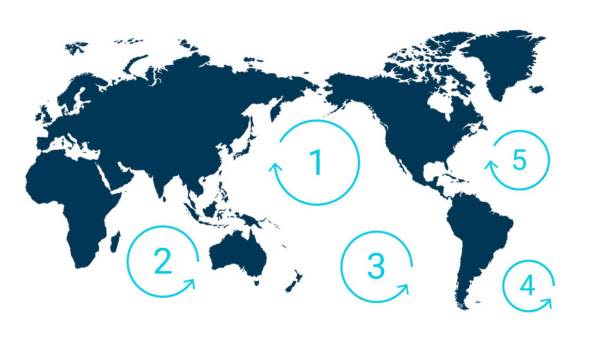
The Great Pacific Garbage Patch (GPGP) is the largest of the five offshore plastic accumulation zones in the world's oceans. It is located halfway between Hawaii and California. (The Ocean Cleanup)
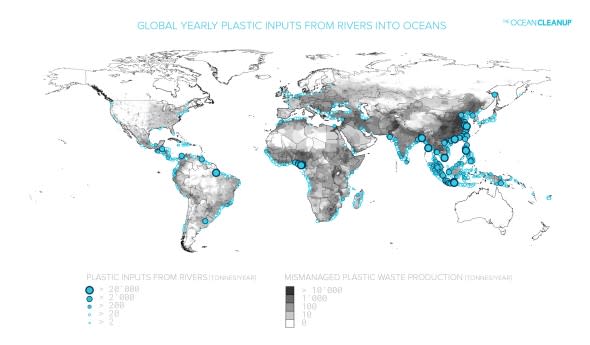
Global yearly plastic inputs from rivers into oceans, 2017. (The Ocean Cleanup)
How does plastic and other debris accumulate in the ocean?
It is estimated that 1.15 to 2.41 million tons of plastic are entering the ocean each year from rivers, according to the Ocean Cleanup.
More than half of this plastic is less dense than the water; therefore, it will not sink once it encounters the ocean.
"The stronger, more buoyant plastics show resiliency in the marine environment, allowing them to be transported over extended distances. They persist at the sea surface as they make their way offshore, transported by converging currents and finally accumulating in the patch," according to the Ocean Cleanup website.
Plastic accumulates at ocean sites, known as gyres, where converging winds and ocean currents meet. An ocean gyre is a system of circular ocean currents formed by the Earth's wind patterns and the forces created by the rotation of the planet, according to National Geographic.
The circular motion of the gyre draws debris into the stable, calm center, where it becomes trapped.
"Once these plastics enter the gyre, they are unlikely to leave the area until they degrade into smaller microplastics under the effects of sun, waves and marine life," according to the Ocean Cleanup website.
Plastic and marine debris has been accumulating in these ocean gyres since the usage of these materials began.
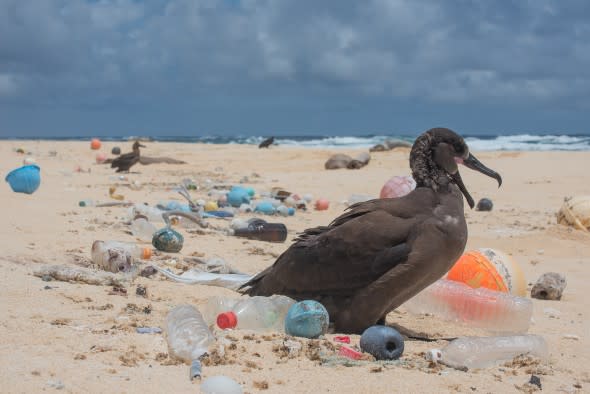
A bird surrounded by ocean plastic on the Northwestern Hawaiian Islands. (The Ocean Cleanup/Matthew Chauvin)
Where does the plastic and marine debris from?
The plastic enters the ocean from land-based sources all over the world, such as from people disposing of their waste improperly or littering. It is difficult to determine exactly where it is coming from, according NOAA Marine Debris Program Director Nancy Wallace.
The Great Pacific Garbage Patch, or the Pacific Gyre, covers such a vast amount of area that there's plastic coming from all over.
There's a lot coming from the Asian side and countries that are dealing with waste management issues, but the United States also contributes a lot, according to Wallace.
"It's not fair to blame one country or another," Wallace said. "Unfortunately, we're all contributing to this accumulation of plastic. It's very difficult to trace back to one area or another."
What is the composition of the plastic?
The phrase 'plastic accumulation' may lead many to picture an island of plastic. But in reality, it is a massive area where marine debris is dispersed throughout.
"You can actually sail through the area without knowing you're in it. It can be really tiny pieces of plastic or it can be big nets and fishing gear. It is dispersed throughout the water column, so it may not all be at the surface," Wallace said.
Marine debris comes in different shapes and sizes. The Ocean Cleanup found that 92 percent of the mass is compromised of larger objects and 8 percent of the mass contains microplastics in the GPGP. Those numbers are rough estimates and are constantly changing.
Microplastic is defined by NOAA as pieces less than 5 millimeters in size. They are tiny pieces of plastic but are still visible. For example, objects that are smaller than a bottle cap.
Meanwhile, larger plastic and other types of debris, such as glass bottles and cans, are larger than that. They are generally things that haven't broken down as much, according to Wallace.
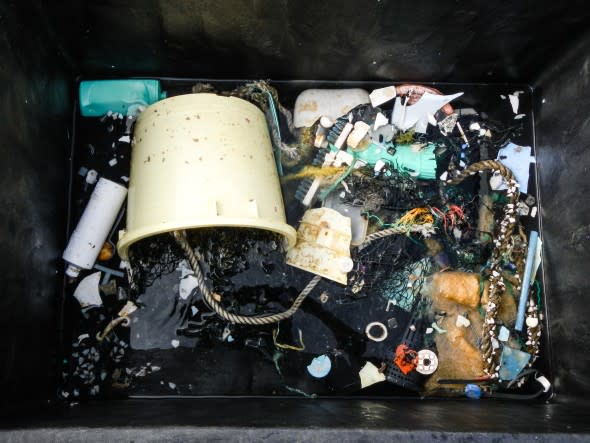
Plastic samples collected during the Mega Expedition, 2015. (The Ocean Cleanup)
How does plastic affect marine ecosystems?
Marine debris can be harmful to ocean ecosystems. Bigger marine debris, especially fishing gear, can entangle whales or sea turtles. Meanwhile, smaller pieces of marine debris can be ingested.
"If you see a seabird that skims the top of the ocean, a lot of the time it will ingest a pollutant at the top of the ocean. It can make them feel full, so they're not going to get real nutrition. It can also lacerate their insides if it's sharp," Wallace said.
Smaller pieces of plastic may accumulate different chemicals or different pollutants that are already in the ocean. These plastic pieces are consumed by marine life, which humans then potentially eat.
"We (NOAA) wants to investigate what the impacts of that are. We don't know if there is an impact on human health yet, but it's a thing that there is a lot of research is going [on] about now," Wallace said.
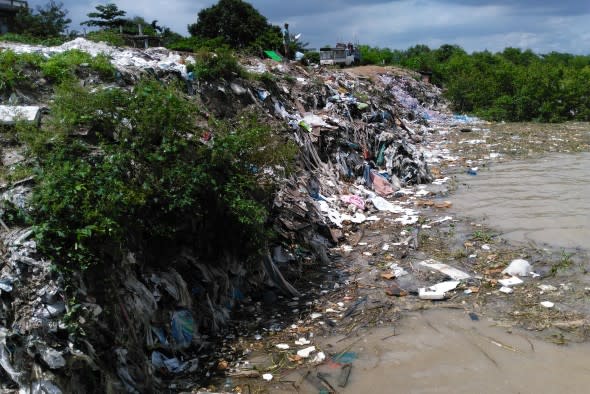
Waste on a river bank, Myanmar, September 2016. (The Ocean Cleanup)
What are the solutions to this issue?
There are solutions that can help to reduce this issue, such as recycling, using less plastic and developing better waste management systems.
"It's very hard to clean it up once it is already out there," Wallace said. "But what we can do is use less. If we generate less waste, there is less waste that can enter into the ocean. If we do use the product, we can make sure that we can reuse it or recycle it, get some additional life out of it."
Individual actions can have a major impact on reducing the problem.
"Many environmental issues are a little less tangible, and it is a little harder to figure out what you personally can do. But for this issue, the cumulative actions of all of us can have a really significant impact," Wallace said.
There are also waste management programs and infrastructure in place that can help to reduce waste from entering the ocean.
For example, there are trash traps in the rivers in Washington, D.C. Debris will accumulate in these traps and then will be cleaned up before it can get out to the larger bodies of water.
"Everybody is contributing to the problem, and there are absolutely things that we can do. I always say that this is a human-made problem. It is our trash floating out there, but the good news is that we actually influence it," Wallace said.
